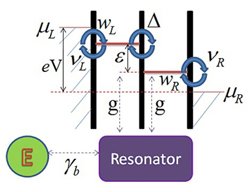A team of researchers from the National University of Singapore’s Centre for Computational Science and Engineering and Zhejiang University has developed a new technique to control the interaction between electrons and vibrations on electronic transport.

This technique paves the way to effectively control data transportation in quantum computers as it improves the transportation of qubits, which are information encoded in electrons. The research team devised an electron transport model to evaluate the current fluctuations of electrons under the influence of phonons, which are quantized modes of vibration.
In the model, a nanomechanical resonator is used for exciting the phonons. The resonator is connected to a system known as double quantum dot (DQD), which can detain one or multiple electrons, to effectively examine the electron transport.
In this study, contrary to earlier studies, powerful random coupling regimes are imposed between the phonons generated by the resonator and electrons in the DQD. The researchers were able to control the phonon excitations without affecting the transportation of qubits. To achieve this, the researchers have utilized coherent phonon states method to decouple the interaction between the phonons and the electrons. The coherent phonon states technique is relied on attaining phonon resonance modes.
The research team has demonstrated that electrons can attain resonance and travel from one quantum dot to another if the surplus energy between the DQD system’s two quantum dots is adequate to form an integer number of phonons. Multi-phonon excitations in powerful electron-phonon coupling regimes improve the electron transport. When the electron-phonon coupling becomes more powerful, the phonon scattering phenomenon suppresses the electron transport and detains the electrons. Thus, electron current fluctuations can be controlled effectively by adjusting the electron-phonon coupling, making it a better quantum switch for controlling the data transportation in quantum computers.